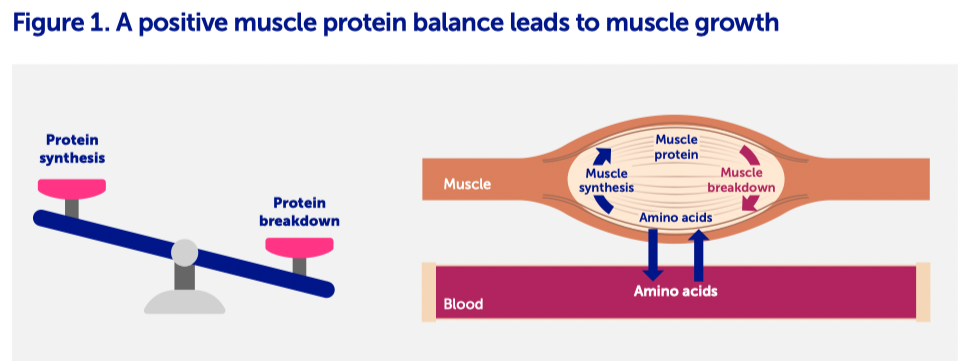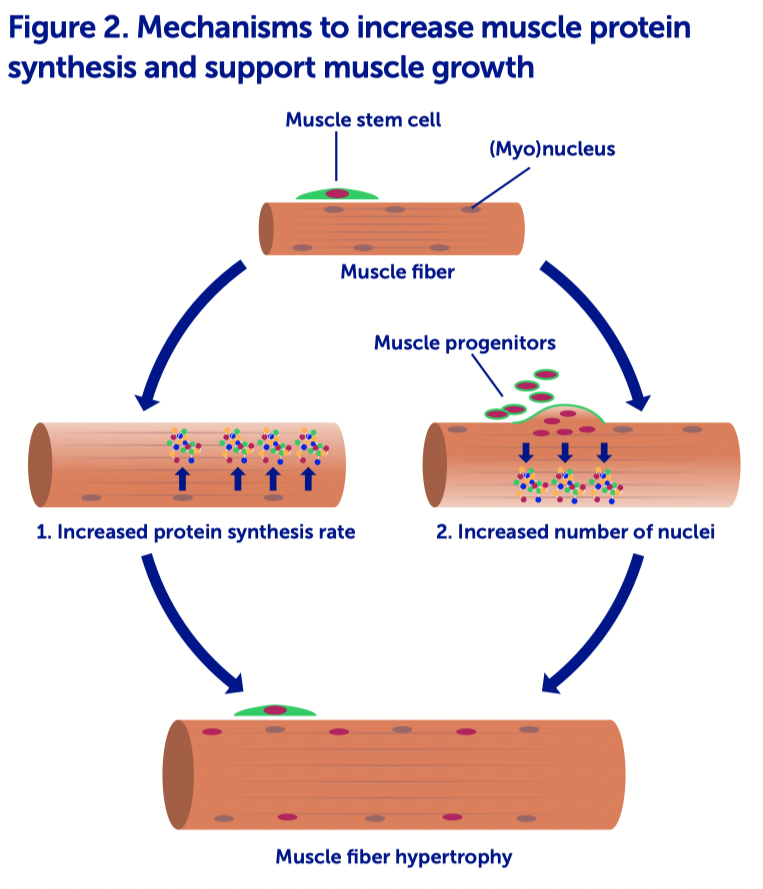Muscle growth in children
Muscle is an important organ that greatly contributes to lean body mass and supports crucial functions of the body such as locomotion and respiration but has also important metabolic roles including glycemic control and whole-body energy and protein metabolism. Childhood is a critical period for muscle growth, which contributes to healthy body composition supporting optimal activity in kids and healthier future.
Key messages:
• Muscle is an important organ that greatly contributes to lean body mass and supports crucial functions of the body such as locomotion and respiration but has also important metabolic roles including glycemic control and whole-body energy and protein metabolism.
• Childhood is a critical period for muscle growth, which contributes to healthy body composition supporting optimal activity in kids and healthier future.
• Muscle growth is supported by a decreased protein breakdown or increased protein synthesis. The capacity for protein synthesis is both dictated by the protein synthesis rate resulting from the activity of each individual nucleus, as well by the number of nuclei in each muscle fiber.
Maintaining healthy skeletal muscle is a major determinant of the quality of life across the lifespan.1 Skeletal muscle, the largest tissue by mass in the body, is well known for its role in locomotion, body posture, and respiration but is also important for whole-body metabolism due to its essential role in protein/lipid metabolism as well as glucose and energy homeostasis. Healthy skeletal muscle development is also important for longitudinal growth through a two-way mechanical and biochemical bone-muscle interaction.2 The first two decades of life is a period of intense growth. Specifically, muscle is growing at its highest rate during the first years of life and during puberty. These periods represent critical windows for establishing healthy skeletal muscles. Disruption during these periods, for example due to suboptimal nutrition, may result in muscle mass deficit that can persist later in life and have negative impact on overall health. Therefore, it is crucial to reach normal muscle quantity and quality during childhood to support optimal physical activity and body composition for a healthier future.
Each skeletal muscle is composed of many long cylindrical-shaped fibers bundled together. These muscle fibers are formed before birth from the fusion of muscle progenitor cells resulting in long multinucleated cells, a specific feature of skeletal muscle cells. The nucleus houses the cell’s DNA and directs the synthesis of ribosomes (the cellular machinery that assembles proteins) and proteins. Muscle growth occurs when muscle protein synthesis exceeds muscle protein breakdown (Figure 1). During sustained periods of growth, a characteristic of childhood, muscle growth is supported by an increase in protein synthesis3 the extent of which is determined by the protein synthesis rate resulting from the activity of each individual nucleus, as well by the number of nuclei in each muscle fiber (Figure 2).

Increasing the number of nuclei is possible thanks to a population of muscle progenitors that persist after birth, called muscle stem cells. During periods of intense muscle growth, these muscle stem cells undergo extensive proliferation and fusion with existing muscle fibers, thereby adding nuclei and allowing muscle fibers to grow (Figure 2). This mechanism is particularly important for the rapid gain in length and width of muscle fibers that happens during the first years of life.4 The influence of nutrition on the regulation of muscle stem cells is largely unknown but may represent an interesting way to promote muscle growth during this critical period of life, especially in challenged populations like low-birth-weight infants or children experiencing faltering growth.
Regulation of muscle protein turnover has been extensively studied and based on adult literature, it is well known that protein synthesis is highly stimulated by physical activity5 as well as by dietary protein intake.6 Notably, protein is needed for normal growth and development in children and contributes to muscle mass growth.

Animal proteins and specifically milk proteins (casein and whey protein) are one of the highest quality-proteins, given their high essential and branched-chain amino acid and leucine content. In adults it is well known that the milk proteins effectively stimulate muscle protein synthesis rates,7 leading to improved muscle mass, strength and functional performance.8 While cohort and cross-cultural studies suggest that milk intake can increase height and associated muscle growth in children,9 further randomized controlled trials would be necessary to define which amount of protein at what time of the day is optimal.
Acknowledgements:
The authors would like to thank Elizabeth Offord (PhD) and Eline van der Beek (PhD), for critical review of the manuscript.
References
1- Orsso et al., 2019. Low muscle mass and strength in pediatrics patients: why should we care? Clin Nutr. 38(5):2002-2015
2- Brotto et al., 2015. Bone and muscle: Interactions beyond mechanical. Bone 80:109-114.
3- Davis & Fiorotto, 2009. Regulation of muscle growth in neonates. Curr Opin Clin Nutr Metab Care. 12(1):78-85
4- Bachman et al., 2018. Prepubertal skeletal muscle growth requires Pax7-expressing satellite cell-derived myonuclear contribution. Development 145(20).
5- Chesley A, MacDougall JD, Tarnopolsky MA, Atkinson SA, Smith K. Changes in human muscle protein synthesis after resistance exercise. J Appl Physiol (1985). 1992 Oct;73(4):1383-8.
6- Groen BB, Horstman AM, Hamer HM, de Haan M, van Kranenburg J, Bierau J, Poeze M, Wodzig WK, Rasmussen BB, van Loon LJ. Post-Prandial Protein Handling: You Are What You Just Ate. PLoS One. 2015 Nov 10;10(11):e0141582.
7- Pennings B, Boirie Y, Senden JM, Gijsen AP, Kuipers H, van Loon LJ. Whey protein stimulates postprandial muscle protein accretion more effectively than do casein and casein hydrolysate in older men. Am J Clin Nutr. 2011 May;93(5):997-1005.
8- Snijders T, Leenders M, de Groot LCPGM, van Loon LJC, Verdijk LB. Muscle mass and strength gains following 6 months of resistance type exercise training are only partly preserved within one year with autonomous exercise continuation in older adults. Exp Gerontol. 2019 Jul 1;121:71-78. doi: 10.1016/j. exger.2019.04.002. Epub 2019 Apr 9. PMID: 30978433.
9- Millward DJ. Interactions between Growth of Muscle and Stature: Mechanisms Involved and Their Nutritional Sensitivity to Dietary Protein: The Protein-Stat Revisited. Nutrients. 2021 Feb 25;13(3):729.
